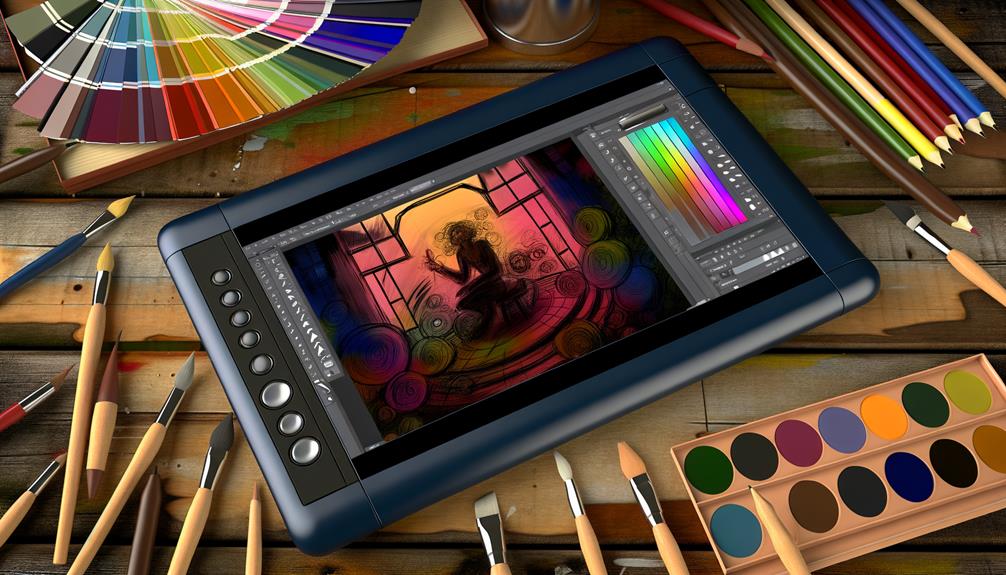
I've analyzed the popular paint edging tool, and while it promises precise edges, it disappoints in reality. The tool is made of flimsy plastic that breaks easily, and it only performs well on perfect 90-degree corners. Users, including myself, noticed that paint accumulates on the wheels, causing a mess rather than a clean line. With no instructions provided, figuring it out can be frustrating. Traditional methods, like masking tape and quality brushes, provide superior results. If you're considering alternatives or want more insights into painting techniques and tools that deliver, you'll definitely find what's useful here.
Key Takeaways
- The paint edging tool is criticized for its cheap plastic construction and poor durability.
- Users report the tool performs well only on perfect 90-degree corners.
- Packaging lacks instructions and arrives in a taped bag, leading to user confusion.
- Paint accumulation on wheels and lint transfer cause messy and uneven painting.
- Traditional masking tape and high-quality brushes are recommended for better results.
Product Overview
When I first tried the paint edging tool, I hoped it would live up to its promise of making painting easier without the hassle of masking tape. Priced at $34.95, it arrived disappointingly packaged in just a bag with tape, lacking any instructions or identification.
Constructed from cheap plastic, the tool's roller and brush components felt flimsy, and indeed, they broke easily during use. Its performance was limited to perfect 90-degree corners, struggling on textured or uneven surfaces.
Despite its shortcomings, social media buzzed with misleading claims, exaggerating the tool's effectiveness. It's clear that the marketing doesn't match the reality, and prospective buyers should approach these claims with caution to avoid potential dissatisfaction.
Design and Quality
How did this paint edging tool miss the mark so widely in its design and quality?
The material selection is its first downfall, as it's made of cheap plastic akin to dollar store items. This choice affects durability and user safety, with users frequently reporting breakages.
The manufacturing processes seem compromised, evident in the flimsy roller and brush parts that fail to deliver precise paint application.
Packaging, too, lacks thoughtful design, arriving in a taped bag with no instructions, heightening user confusion.
Paint tends to accumulate on the wheels, leading to messy outcomes.
These design shortcomings severely compromise the tool's effectiveness and reliability, making it a poor choice for those seeking quality and safety in their painting projects.
User Experience
From a user experience standpoint, the paint edging tool leaves much to be desired, particularly on textured or uneven surfaces.
User feedback highlights significant usability concerns, as the tool's effectiveness is limited to perfect 90-degree corners. Many users noted that initial results seemed satisfactory but deteriorated quickly, with issues like paint accumulating on the wheels and lint transferring onto surfaces.
This led to messy applications and frustration, impacting overall customer satisfaction. The consensus is that traditional masking tape offers cleaner edges, suggesting the paint edging tool fails to meet user expectations.
The design's flimsy nature often results in breakage during use, amplifying negative experiences. Overall, these shortcomings contribute to a subpar user experience, discouraging long-term use.
Performance Issues
The paint edger's performance leaves much to be desired, especially on textured or uneven surfaces, making it effective only on flawless 90-degree corners.
My experience showed that initial results might appear decent, but the tool's performance deteriorates quickly. It accumulates paint on its wheels, leading to uneven application. Lint transfer during use further undermines the finish's quality.
Effective application techniques require meticulous surface preparation, yet even then, the tool falters without masking tape. Despite its claims, the edger frustrated my efforts, deviating from promised standards.
Many users echo these sentiments, emphasizing traditional painting tips over this tool. Consistent negative reviews suggest its inability to meet expectations, highlighting a significant gap between marketing and real-world performance.
Recommended Alternatives
When searching for effective painting tools, I've found that traditional methods often outperform the much-hyped paint edger. The Montauk's Premiere Pro brush stands out for its ability to create clean edges, free from the mess of gimmicky tools.
A three-inch angle sash brush is my go-to for cut-ins, providing precision and control. Selecting bristle types is essential; synthetic bristles work best for latex paints, while natural ones excel with oil-based finishes.
The Brook brush is another reliable choice, offering superior craftsmanship for various tasks. Brush maintenance tips, like cleaning after each use, extend their lifespan and performance.
Utilizing high-quality brushes, paired with masking tape, enhances results and makes painting more enjoyable than relying on subpar tools.
